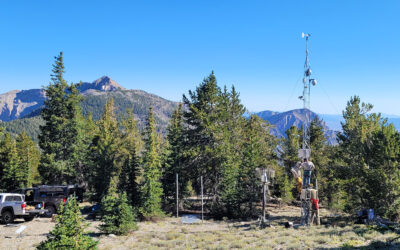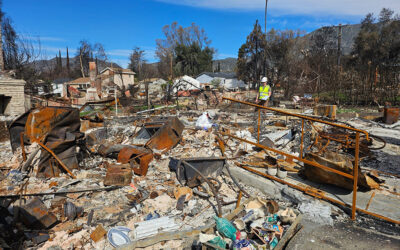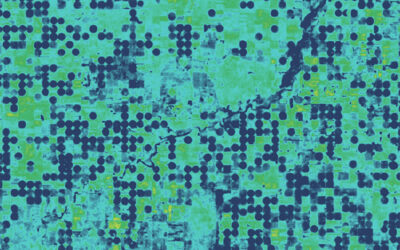DRI scientists, agency leaders, and state assemblymembers discuss some of the West’s most pressing water issues.
On March 27, DRI scientists gathered at the State Capitol to illuminate work that supports Nevada’s communities and landscape. With more than 600 scientists, engineers, students, and staff across our Reno and Las Vegas campuses, we conducted more than $52 million in sponsored research focused on improving peoples’ lives in 2024 alone.
With Nevada’s status as the driest state in the nation, water is at the center of many discussions about sustainable economic development, responsible natural resource management, population growth, and agriculture. Our scientists consistently contribute expertise to state policymakers on topics ranging from groundwater management to drought monitoring and reservoir evaporation rates. With about 90% of southern Nevada’s water supply coming from the Colorado River, our work on this critical watershed helps decision makers understand the future of water availability for communities.
As part of DRI’s dedication to informing state legislators about the best available science on all things water, our leaders held an open discussion panel on the topic. Led by DRI’s President, Kumud Acharya, the panel included Assemblymember Howard Watts; Zane Marshall, Director of Water Resources for the Southern Nevada Water Authority (SNWA); John Zimmerman, General Manager of the Truckee Meadows Water Authority (TMWA); Adam Sullivan, the State Engineer and Administrator of the Nevada Division of Water Resources (NDWR); and Sean McKenna, Executive Director of DRI’s Division of Hydrologic Sciences. The panel covered a wide variety of water-related topics.
Understanding Nevada’s Water: The Nevada Water Initiative
The panel opened with a discussion of the partnership between DRI and NDWR to update the state’s baseline water data, called the Nevada Water Initiative. With current water management decisions based on information that was acquired between 70 and 50 years ago, water managers are looking to use rapid scientific advancements in the field to collect an accurate picture of just how much water the state has to go around.
“There’s a great history of Nevada really being a leader with groundwater science and in the mid part of the 20th century, recognizing that we really needed to understand how groundwater works and how to estimate water budgets to support the administration of water,” Adam Sullivan of NDWR said. “The way I see it, the Nevada Water Initiative is raising the bar to keep Nevada as a leader in groundwater science… We need to apply the science we have now and integrate that into how we administer water resources in the state so that we can get ahead of problems and support economic development.”
DRI scientists are conducting fieldwork statewide and using advancements in acquiring environmental data via satellites to assess nearly every aspect of water. This includes how groundwater is replenished and how it moves between basins, where springs bring groundwater to the surface, and how evaporation reduces surface water availability. As the team gathers data, it is added to publicly available portals on NDWR’s website.
President Acharya guided the discussion to the concept of the “perennial yield,” which is an estimate of the water budget for a particular basin. NDWR’s Sullivan explained how the Nevada Water Initiative is seeking to look beyond basin-scale water budgets to create a comprehensive view of water availability.
“Nevada’s really unique among Western states to have this principle, or this intent of not developing water beyond what we have available indefinitely,” Sullivan said. “It’s a guideline for determining water availability, which encompasses a lot more than just the basin scale water budget. Water availability is how water is used, where it’s used, what the consumptive use is. With the Nevada Water Initiative, we’re looking beyond just the perennial yield as a guideline to really make good determinations about water availability.”
For water rights holders who may be wary of potential changes due to the updated data, Sullivan was reassuring:
“Having certainty in these long-term projections is how we be more realistic about what the water budget can support in the long term that benefits the water rights holders as well as the administrator,” he said. “So we know what the options are, we can get ahead of problems, and be proactive, so that we can honor the water budget and do the best thing for the communities that are affected.”
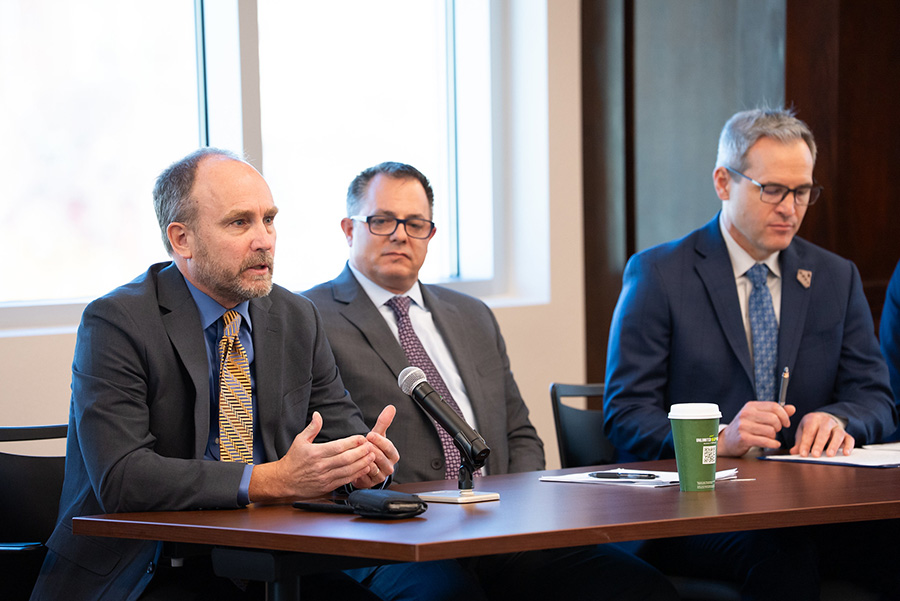
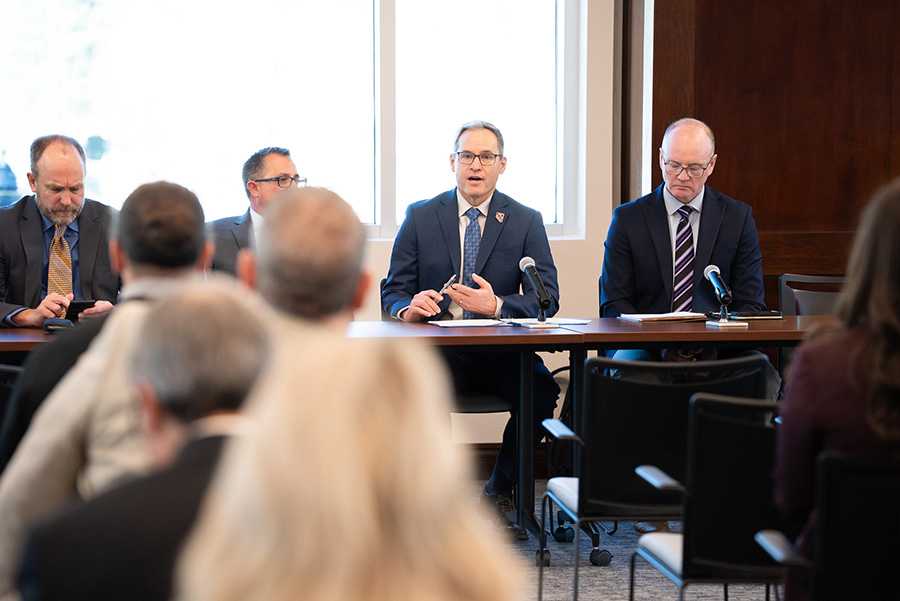

Challenges on the Colorado River
The Colorado River’s declining flows are well documented, and with approximately 90% of southern Nevada’s water supply dependent on the dwindling river, our state is at the center of water management discussions. Beyond Nevada, about 40 million people throughout the West rely on the vast Basin’s water, which stems from melting Rocky Mountain snow. Scientists have documented decreases in the river’s flows even during years when the snowpack is at historical average, with some changes attributable to altered weather patterns that increase evaporation. With flows lower than they were in 1922 — when the river’s water was originally divided up — or when the allocations were revisited in 2007, ongoing discussions seek to bridge the gap.
It’s a conversation that Zane Marshall, of SNWA, is following closely. “Conditions are significantly different today than they were when the 2007 guidelines were negotiated because we have less water in the Basin,” he said. “Reservoirs are at 35% of capacity.”
States in the upper part of the Basin, like Colorado and Wyoming, are in disagreement with those in the lower Basin, like Nevada and Arizona, about who should take the cuts.
“I think it’s important to acknowledge that we’re talking about doing hard things,” Marshall continued. “There are businesses and families and homes and cities that depend on these supplies, and the entire Basin — all sectors — everybody is going to have to participate in the solution.”
President Acharya noted the vast water conservation efforts that southern Nevada has promoted and achieved in recent decades, with Las Vegas residents using less water per capita today than in the 1990s. Much of this progress is attributable to work done by the SNWA, which has been developing drought contingency plans that focus on regulation and incentives, education, outreach, and variable pricing tiers.
“But as we moved through the 2000s, conditions on the river have continued to decline with this – not just drought, but aridification of the Basin,” said Zane Marshall of SNWA. “So, we have revised those approaches to focus on consumptive uses, because 60% of what we deliver in the valley is consumptive use… We’ve done some hard things as a community. And part of that success story of conservation is making sure that our elected officials understand the circumstances and working with the business community and our broader community.”
Assemblymember Watts, who has served in or chaired the Natural Resources Committee in every legislative session since he took office in 2018, pointed to southern Nevada’s successes. “In my opinion, Nevada is the clear leader among the Colorado River Basin states, because we’re constantly looking for new solutions,” he said. “We’ve adapted from the state all the way down to the local levels… We’ve done an incredible job collectively coming together as a community and making decisions and putting policies in place that help drive down use and conserve the resource. I think those policies have been kind of a beacon for others across the Colorado River Basin.”
The Las Vegas metro area returns about 40% of its water back to Lake Mead thanks to the region’s conservation efforts, which enables the city to extend the water supply. DRI scientists contribute to southern Nevada’s conservation efforts in part by evaluating how evaporation impacts Lake Mead’s water levels. The increasingly hot and dry weather is leading to higher evaporation off all the Basin’s reservoirs, leading to even further declines in water availability for communities. Three times more water evaporates from Lake Mead than Nevada receives as its share of the Colorado River.
“In the Colorado Basin, we’re in one of the more significant dry spells of the last 1200 years, according to tree ring records,” said DRI’s Sean McKenna. “How long is that going to last? We don’t know, but we are starting to see fundamental changes in the Upper Basin in how the snowpack responds to either less snow or drier conditions. And that changes spring flow.”
In addition to measuring reservoir evaporation to contribute to water allocation decisions, DRI recently published a detailed report on evapotranspiration and water use for the Upper Basin over the last 30 years.
Water in the Sierra
Northern Nevada gets much of its water from the Sierra Nevada mountains which buffers it from the troubles of the declining Colorado River. Although the region’s snow is not immune to the long-term weather shifts impacting the Rocky Mountain’s snowpack, many recent years have avoided severe drought conditions. However, responsibly planning for the future involves preparing for a shift to winters with more rain and less snow.
DRI scientists are helping TMWA adapt to warmer winter conditions by developing methods to forecast rain-on-snow storms, which cause the snowpack to melt prematurely and raise the risk of downstream flooding.
“We’re looking at forecasting for our reservoir operations, so that if we have earlier runoff, or if there’s more rain instead of snow coming down, we want to be able to store those upstream reservoirs sooner in the season,” said John Zimmerman of TMWA. “Those reservoirs are our flood control, and they’re based on Army Corps of Engineers data from the 1980s. We’re trying to update that. We’re also partnering with the City of Reno on a $240 million plant that would take reclaimed water, treat it to a higher standard than drinking water, and inject that into the ground for groundwater storage.”
The Reno area is also more prone to wildfires than the southern part of the state, and these fires are contributing to changes in water availability for the region. Scientists are still attempting to disentangle the complex relationship between fire, snowpack, vegetation, and soil moisture, DRI’s Sean McKenna says. One clear impact is the way that ash can act like a black sweater on the snowpack and cause premature melting. However, efforts to prevent wildfires, like controlled burns, can actually result in more water availability, because there is less vegetation to take up surface and groundwater.
With the middle fork of the Truckee River supplying more than 80% of Reno’s water, the region is fortunate that a catastrophic fire hasn’t occurred in the watershed in recent years. This could impact not only water availability and flooding risk, but the quality of the water and costs for treating it. “We have to make sure our system is redundant,” TMWA’s Zimmerman said. “There are multiple water supplies in each specific zone in our service area. It’s one of the most complicated systems in the West.”
DRI also adds additional water to watersheds across Nevada and the West through cloud seeding. This decades-old technique involves supplementing atmospheric dust particles to give storm clouds the ice nuclei necessary to transform water vapor into precipitation. DRI’s cloud seeding team operates ground-based generators in mountain ranges across the state, bringing more water to Nevada communities, ranches, and natural landscapes.
With DRI scientists working every day to pursue answers to society’s most pressing scientific questions, conversations like these are critical for connecting science with those seeking to build a better future for our communities. To support science that matters now, visit the DRI Foundation website.
——
More about the Water Panelists:
· Assemblymember Howard Watts represents Assembly District 15 in southern Nevada. He was first elected in 2018. He has served in or chaired the Natural Resources committee in every session since he took office. This session, he also serves as chair of Growth and Infrastructure and also serves on Ways and Means.
· Adam Sullivan serves as the State Engineer and Administrator of the Nevada Division of Water Resources. As State Engineer, he is responsible for managing and protecting Nevada’s water resources. Adam has been with the State Engineer’s office since 2009 and led the office since late 2020.
· Zane Marshall, Director of Water Resources for the Southern Nevada Water Authority. Zane has worked for the Southern Nevada Water Authority (SNWA) for the past 28 years. In his current role as Director of Water Resources, Zane leads seven divisions that oversee water, land, and environmental resource management, environmental restoration and compliance, regional water conservation, climate change, and sustainability initiatives, and the application of geospatial technologies.
· John Zimmerman is General Manager of the Truckee Meadows Water Authority. John has been with TMWA since 2016 and has served as general manager for the last three years. He has been instrumental in developing water policy through collaboration with federal, state, local and tribal governments on behalf of TMWA. He has extensive experience in water law, with applicable expertise regarding operation of the Truckee River system.
· Sean McKenna, Executive Director, DRI’s Division of Hydrologic Sciences. Sean leads a group of more than 100 research faculty and scientists. The Division of Hydrologic Sciences works to advance knowledge of hydrologic processes including ground water, surface water, evapotranspiration, precipitation and snowmelt.
